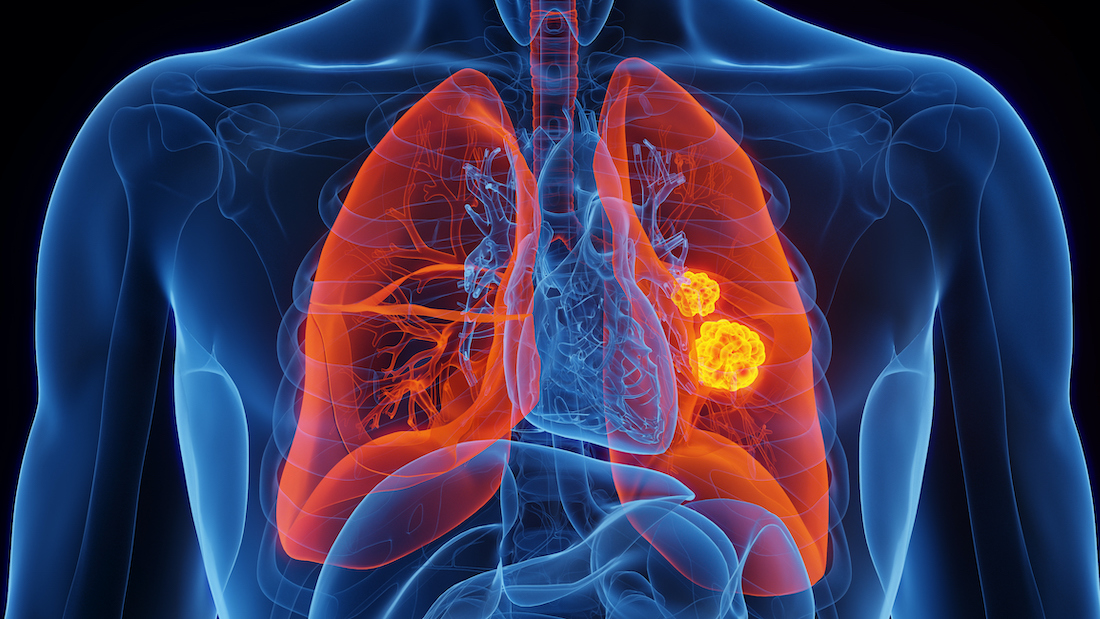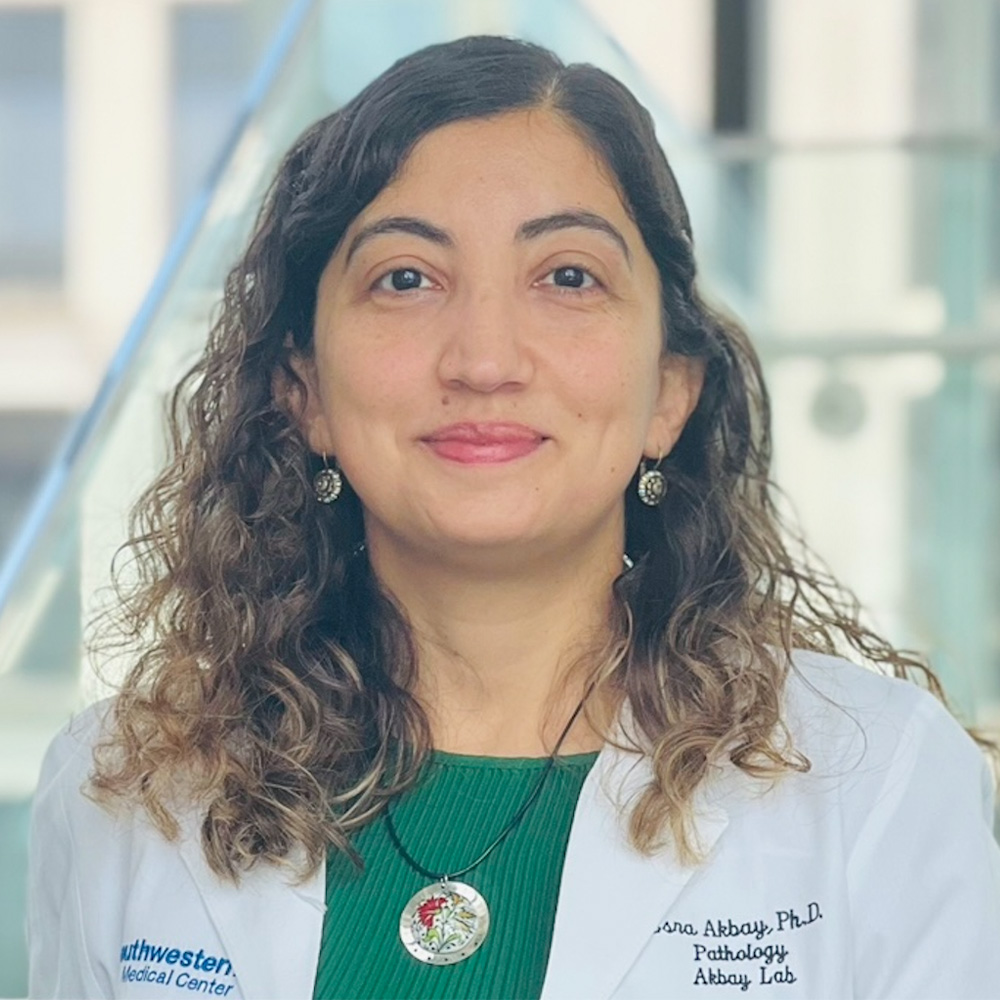Lung cancer treatment shows promise in tumor models
UT Southwestern study uses 6-thio-dG molecule to damage DNA and halt spread of small cell lung cancer

DALLAS – March 11, 2024 – A molecule has demonstrated its ability to kill tumor cells and incite an immune response in preclinical models of small cell lung cancer (SCLC), according to UT Southwestern Medical Center researchers. The findings, published in Nature Communications, could lead to more successful treatments for SCLC, one of the leading causes of cancer-related deaths in the U.S.

“We have a really exciting new drug that could target a disease that’s very difficult to treat,” said Esra A. Akbay, Ph.D., Assistant Professor of Pathology and a member of the Development and Cancer Research Program of the Harold C. Simmons Comprehensive Cancer Center at UT Southwestern. “This research marks a crucial step toward potentially reshaping the standard of care for small cell lung cancer patients.”
With more than 32,000 new cases expected to be diagnosed in the U.S. in 2024, SCLC is a particularly lethal cancer with limited effective treatment options. While SCLC tumors may initially respond to therapeutics, they’re highly metastatic and tend to develop treatment resistance. They’re also successful at concealing themselves from the body’s immune system.
Scientists believe that treatment resistance is tied, in part, to the abundance of cancer-initiating cells (CICs) in these tumors that, in turn, increase the total number of SCLC cells and drive their migration and spread to other organs. CICs produce telomerase, an enzyme that preserves telomeres, which are the protective caps at the end of DNA sequences. Normal cells die or senesce as their telomeres shorten over time. In cancer cells, however, the telomerase enzyme helps cancer cells maintain their telomeres, live longer, and metastasize.
Dr. Akbay and her team devised a series of tests using the telomere-targeting molecule 6-thio-2’-deoxyguanosine (6-thio-dG). After entering the bloodstream, 6-thio-dG is rapidly incorporated into tumor cells where it damages telomeres and causes cell death while at the same time sparing healthy cells.
“It’s difficult to devise treatments that affect cancer cell DNA because most of the time they’re also toxic to bone marrow cells, which produce immune and blood cells,” Dr. Akbay explained. “But 6-thio-dG is nontoxic to healthy cells in therapeutic doses.”
Dr. Akbay’s team tested the efficacy of 6-thio-dG both in vitro and in mouse models and found that it inhibits the growth of SCLC cells, even those resistant to chemotherapy.
The drug also had positive effects on the tumor immune environment. Researchers found that 6-thio-dG makes SCLC in mice more visible to the immune system. It increased recruitment of T cells and natural killer cells and decreased the presence of myeloid cells that can promote tumor growth. In mice with intact immune systems, they found that 6-thio-dG can sensitize SCLC cells to radiation treatment.
Other UTSW researchers who contributed to this study are co-first authors Buse Eglenen-Polat, M.D., and Ryan R. Kowash, B.S., with the Akbay Lab; John D. Minna, M.D., Director of the Hamon Center for Therapeutic Oncology Research and Professor of Internal Medicine and Pharmacology; Jerry W. Shay, Ph.D., Professor of Cell Biology; Prithvi Raj, Ph.D., Associate Professor of Immunology and Director of the Microbiome Research Lab; Benjamin J. Drapkin, M.D., Ph.D., Assistant Professor of Internal Medicine in the Division of Hematology and Oncology; Lin Xu, Ph.D., Assistant Professor in the Peter O’Donnell Jr. School of Public Health and Pediatrics; Akbay Lab members Mingrui Zhu, Ph.D., Hai-Cheng Huang, M.D., who is a Ph.D. candidate, and Matthew Bender, B.S.; Shay Lab member Silvia Siteni, Ph.D.; Minna Lab member Victor Stastny, B.S.; and Kenian Chen, Ph.D., Computational Biologist in the Quantitative Biomedical Research Center.
Drs. Akbay, Drapkin, Minna, Shay, and Xu are also members of Simmons Cancer Center.
Dr. Akbay is a Cancer Prevention and Research Institute of Texas (CPRIT) Scholar in Cancer Research. Dr. Minna holds the Max L. Thomas Distinguished Chair in Molecular Pulmonary Oncology and the Sarah M. and Charles E. Seay Distinguished Chair in Cancer Research. Dr. Shay is a Distinguished Teaching Professor and holds The Southland Financial Corporation Distinguished Chair in Geriatrics.
This study was supported by a CPRIT Scholar Award (RR160080), National Institutes of Health grant (R01CA276058), National Cancer Institute (NCI) Cancer Center Support Grant (P30CA142543), a U.S. Department of Defense grant (W81XWH-21-1-0856), The Welch Foundation (1975-20190330), A Breath of Hope Lung Foundation Fellowship Award (ABOHLF 2020), American Cancer Society Research Scholar Grant (RSG-22-051-01-IBCD), a Mary Kay Ash Foundation grant, NCI Specialized Programs of Research Excellence (SPORE) in Lung Cancer (5P50CA070907), the World Brain Microscopy Core Facility for slide scanning (RRID: SCR_017949); CPRIT Core Facility Support Award (RP180770), and grants U01CA213338 and 5T32CA124334.
MAIA Biotechnology Inc. is developing and commercializing the telomere-targeting agent 6-thio-dG, which has been granted orphan drug designation by the U.S. Food and Drug Administration for SCLC. Dr. Shay is a scientific adviser for MAIA Biotechnology. Drs. Siteni and Shay are named inventors on patents licensed to MAIA Biotechnology (16/450,430; 62/636,775; 62/646,820; 16/304,538; 17/200,539; 63/388,688). Dr. Minna receives licensing fees from the National Cancer Institute and UT Southwestern to distribute cell lines.
About UT Southwestern Medical Center
UT Southwestern, one of the nation’s premier academic medical centers, integrates pioneering biomedical research with exceptional clinical care and education. The institution’s faculty members have received six Nobel Prizes and include 25 members of the National Academy of Sciences, 21 members of the National Academy of Medicine, and 13 Howard Hughes Medical Institute Investigators. The full-time faculty of more than 3,100 is responsible for groundbreaking medical advances and is committed to translating science-driven research quickly to new clinical treatments. UT Southwestern physicians provide care in more than 80 specialties to more than 120,000 hospitalized patients, more than 360,000 emergency room cases, and oversee nearly 5 million outpatient visits a year.
